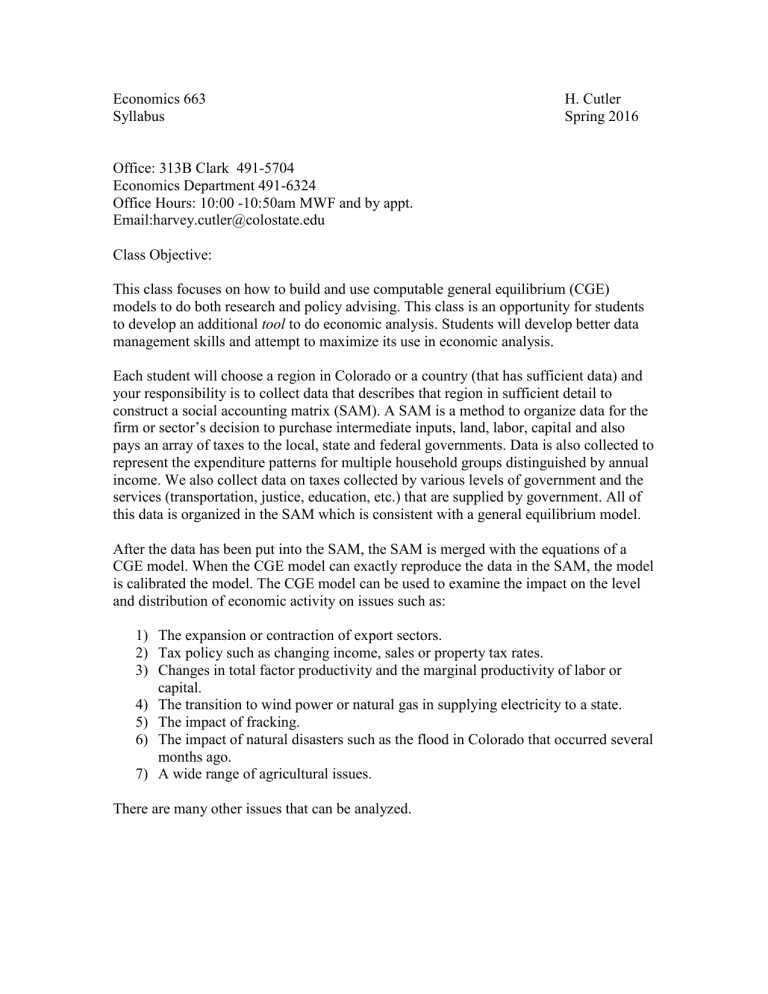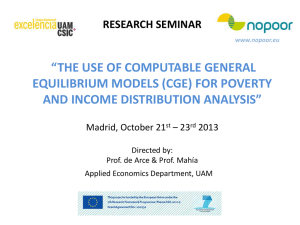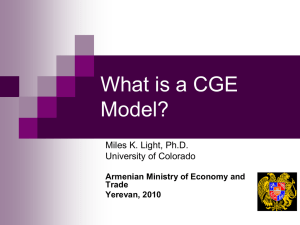Economics 663 H. Cutler Syllabus

Economics 663
Syllabus
Office: 313B Clark 491-5704
Economics Department 491-6324
Office Hours: 10:00 -10:50am MWF and by appt.
Email:harvey.cutler@colostate.edu
H. Cutler
Spring 2016
Class Objective:
This class focuses on how to build and use computable general equilibrium (CGE) models to do both research and policy advising. This class is an opportunity for students to develop an additional tool to do economic analysis. Students will develop better data management skills and attempt to maximize its use in economic analysis.
Each student will choose a region in Colorado or a country (that has sufficient data) and your responsibility is to collect data that describes that region in sufficient detail to construct a social accounting matrix (SAM). A SAM is a method to organize data for the firm or sector’s decision to purchase intermediate inputs, land, labor, capital and also pays an array of taxes to the local, state and federal governments. Data is also collected to represent the expenditure patterns for multiple household groups distinguished by annual income. We also collect data on taxes collected by various levels of government and the services (transportation, justice, education, etc.) that are supplied by government. All of this data is organized in the SAM which is consistent with a general equilibrium model.
After the data has been put into the SAM, the SAM is merged with the equations of a
CGE model. When the CGE model can exactly reproduce the data in the SAM, the model is calibrated the model. The CGE model can be used to examine the impact on the level and distribution of economic activity on issues such as:
1) The expansion or contraction of export sectors.
2) Tax policy such as changing income, sales or property tax rates.
3) Changes in total factor productivity and the marginal productivity of labor or capital.
4) The transition to wind power or natural gas in supplying electricity to a state.
5) The impact of fracking.
6) The impact of natural disasters such as the flood in Colorado that occurred several months ago.
7) A wide range of agricultural issues.
There are many other issues that can be analyzed.
Grading
There will be quite a bit of data gathering for the class. Two primary websites everyone will be using are
http://www.bls.gov/
http://www.census.gov/acs/www/data_documentation/public_use_microdata_sam ple/
Problem Set 1 – 5%
Build a simple SAM for your Colorado region – due January 25
Problem Set 2 – 5%
Develop an operating CGE model from Problem Set 1
Problem Set 2 is February 10
Problem Set 3 – 10%
Class presentation of the CGE equations – February 24
Problem Set 4 - 25%
Construct the complete SAM – March 11
Problem Set 4 is due March 7
Problem Set 5 – 20%
Calibrate the CGE model – April 25
Problem Set 6 – 20%
Run simulations and write a short paper on results – May 2
Problem Set 7 – 15%
Each student will be responsible for one classroom presentation. Topics and time to be specified later.
Readings
I. Surveys of Computable General Equilibrium Models
Partridge, Mark and Dan Rickman, (1998) Regional computable general equilibrium modeling: a survey and critical appraisal, International Regional Science Review
21, 205–248.
__________, (2010) “Computable General Equilibrium (CGE) Modeling for Regional
Economic Development Analysis,” Regional Studies.
Vol.
44.10, pp. 1311–1328,
December.
Wing, Ian Sue (2004) “Computable General Equilibrium Models and Their Use in
Economy-Wide Policy Analysis,” Science and Policy of Global Change, MIT.
II. Economic Resilience of Natural Hazards
Rose, Adam, and Shu ‐ Yi Liao. "Modeling regional economic resilience to disasters: A computable general equilibrium analysis of water service disruptions*." Journal of
Regional Science 45.1 (2005): 75-112.
Cutter, Susan L., et al. "A place-based model for understanding community resilience to natural disasters." Global environmental change 18.4 (2008): 598-606.
Chang, Stephanie E., and Masanobu Shinozuka. "Measuring improvements in the disaster
resilience of communities." Earthquake Spectra 20.3 (2004): 739-755.
Okuyama, Yasuhide. "Economic modeling for disaster impact analysis: past, present, and
future." Economic Systems Research 19.2 (2007): 115-124.
Rose, Adam Z. "A framework for analyzing the total economic impacts of terrorist attacks and natural disasters." Journal of Homeland Security and Emergency
Management 6.1 (2009).
Meyer, Volker, et al. "Review article: Assessing the costs of natural hazards–state of the
art and knowledge gaps." Natural Hazards and Earth System Science 13.5 (2013):
1351-1373.
III. Tax Policy
Altig, D., A. Auerbach, L. Kotlikoff, K. Smetters, and J. Walliser (2001), “Simulating
Fundamental Tax Reform in the United States,” The American Economic
Review, 91(3): 574–595.
Ballard, Charles L., John B. Shoven and John Whalley (1985), “General Equilibrium
Computations of the Marginal Welfare Costs of Taxes in the United States,”
American Economic Review Vol. 75 No. 1 (March): 128-138.
Conroy, Tessa, Harvey Cutler and Stephan Weiler (2015) “The State-Level Impacts of
Enforcing Sales Taxes for E-retail Purchases, Growth and Change, Article first published online: 22 JUL 2015 DOI: 10.1111/grow.12119.
Cutler, Harvey, Stephen Davies and Martin Shields, (2015) “Can State Fiscal Policy
Increase Growth and Reduce Inequality?” Growth and Change (revised and resubmitted)
III. Promoting Economic Growth
Giesecke, James (2002) “Explaining regional economic performance: An historical application of a dynamic multi-regional CGE Model,” Papers in Regional
Science, 81: 247-278.
Cutler, Harvey and Stephen Davies (2010) “The Economic Consequences of Productivity
Changes: A CGE Analysis” Regional Studies, volume 44 No. 10 Dec.: pp. 1414-26.
Cutler, Harvey and Stephen Davies (2007) “The Impact of Specific-Sector Changes in
Employment on Economic Growth, Labor Market Performance and Migration,”
Journal of Regional Science Vol. 47 Issue 5 December: 935-63.
Hoffman, Sandra, Sherman Robinson and Shankar Subramanian (1996), “The Role of
Defense Cuts in the Californian Recession Computable General Equilibrium
Models and Interstate Factor Mobility Journal of Regional Science Volume 36,
Issue 4, pages 571–595, November 1996
V. Environmental
Eboli, Fabio, Ramiro Parrado, and Roberto Roson (2010) “Climate-change feedback on economic growth: explorations with a dynamic general equilibrium model,”
Environmental and Development Economics (Oct): 515-533.
Goulder H. Lawrence and marc Hafstead and Michael Dworsky (2010), “Impacts of alternative emissions allowance allocation methods under a federal cap-and-trade program,” Journal of Environmental Economics and Management Vol. 60 Issue 3
November: 161 -181.
Keyser, David, Harvey Cutler, Terry Iverson, Christopher Hannum, (2015), “Evaluating sub-national climate action: the case of Colorado,” submitted.





